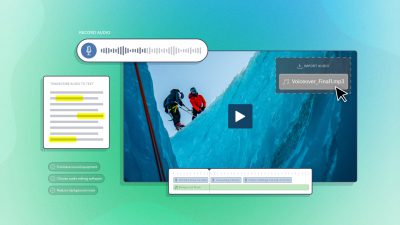Inbound marketing is the art and science of attracting people to your website. The goal is to convert them to leads, customers, and eventually, promoters or brand ambassadors.
Video can be one of the most powerful tools in your arsenal for inbound marketing. Here’s our guide to leveraging video for magnetic inbound marketing.
What is Inbound Marketing?
The idea is to be present and appealing whenever and wherever your prospects are hanging out – online or offline. Having caught their eye, you further intrigue them with content that adds value. Often, you might offer it for free. Other times, you might require some contact information, like an email address.
Once you have a relationship with them, you continue to provide value to nudge them along the sales funnel. Eventually, they should be ready to reward you for all your hard work by paying for a product or service.
By engaging your audience, and helping to spread your message, video can greatly reduce friction in your inbound marketing funnel. In turn, it helps increase conversion rates and lower your cost of acquisition.
Know Who You Want to Reach
Start with at least a concept of your target customer personas. It isn’t really possible to be omnipresent on the internet, unless you are Google, Facebook or Amazon.
Beginning with a narrow view of who you are trying to reach will guide all subsequent decisions. It will help you get early traction, and improve the efficiency of your marketing efforts.
For an in-depth guide to creating customer personas, we love this post by Gregory Ciotti of Help Scout. We also recently published a blog post about developing viewer personas specifically.
The basic concept of developing target personas is to consider the unifying traits of your ideal customers. By strategically identifying their shared traits, you can then segment them according to their needs and interests.
Naturally, their needs and interests extend beyond your products or services. A broader understanding of your target customer personas provides the context in which they are searching for a solution you might offer. Look well beyond their needs for products like yours, and take a holistic view.
This understanding is critical because it allows you to get in their mindset when crafting a content strategy, picking publishing platforms, and engaging with authenticity.
Go Where They Go
With a handle on your target prospects’ needs and interests, you can begin trying to reach them by growing your presence in places they frequent. This could mean online only, or it could be offline, in the form of a networking event or conference.
This may sound like common sense, and to a certain extent it is. But, talk to anyone about how much value they actually got out of the last networking event they attended, and don’t be shocked if they only mention the free drinks.

The key is to go to the right places, not every single place, or just the ones you think will work.
When attending or sponsoring an event, the goal is to bridge the gap to your online presence in a traceable way. Consider using a custom hashtag, running a contest to collect email addresses or to gain more fans or followers, or handing out swag with a link to a custom landing page for the event.
Connecting Online with Authenticity
A similar approach will also work online. And, you’ll have many more tools to work with, in much more scalable ways. Importantly, this is where video really comes into play.
Identify the main online platforms where your target customers spend a lot of their browsing time. As with developing your personas, look for specific niches where you can quickly gain traction right off the bat. Then, expand from there once you have an engaged and active base.
For instance, don’t just share posts on Facebook. Either start or join groups relevant to the specific niche you’re targeting. Then, become active in that community by commenting and sharing interesting content. Be sure to share a mix of original content and content from 3rd parties to avoid coming across as self-promotional.
Think beyond social. Seek out guest publishing opportunities with blogs or complementary websites that your target customers frequent. Look for topical subreddits, Quora questions, or even Yahoo! Answers where you can contribute. Make sure your desired audience is present, and go from there.
Regardless of the specific platforms you are choosing, the goal is to be visible and to provide valuable content. It’s as simple as a helpful comment, tip, or video snippet in the right place, at the right time.
This is relatively easy to do on paper. However, it isn’t easy to do well, and requires actively searching for new opportunities that might be relevant.
Leveraging Video
Since video increases the likelihood people will actually consume and share your content, it is an ideal marketing tool for becoming highly visible on the web.
When planning video content for your inbound marketing strategy, you’ll need to consider these specific factors to get it right:
- Where your target audience is hanging out online
- The formats of video that work well on those platforms
- Your brand and brand voice
- The unique expertise you can offer
- What your audience might find most valuable at this stage
Again, the key here is to provide value. How you achieve that is tied up in your customer personas. How well you personified your ideal customers will dictate how engaging and relevant they find your video content to be, as well as the content surrounding it.
If you missed the mark, you probably need to spend more time on fully understanding their needs or motivations.
Here is a breakdown of the different types of video you need for each stage of your inbound marketing funnel.
Awareness and Engagement
The awareness and engagement phase will largely take place off your own website. A strong off-site strategy can drive significant traffic to your main website.
In all likelihood, your off-site strategy will include social media, guest-blogging, and answering questions on platforms like Quora or Yahoo! Answers. Your audience is almost guaranteed to be frequenting these types of sites.
Short, entertaining, emotional, or educational videos are ideal to include in this phase of your marketing strategy. Video trumps images or text for communicating this type of content because it can offer that all-important human connection.
For guest blogging, or Q&A sites, include short clips in your guest blogs, or create videos answering popularly followed questions.
Social media is increasingly video-centric. This is true for all the major platforms – Facebook, Instagram, Snapchat, Twitter, and LinkedIn.
It’s no wonder – people are more likely to share and engage with video on social media compared to other types of posts. Adding some video to your content mix will help drive interactions and engagement. It doesn’t necessarily have to be original video, but if it is, all the better.
Attracting Visitors to Your Site
Video’s position as the most valuable content form out there stems partly from its impact on your site’s ranking on search engine results pages (SERPs). Video helps with all aspects of search engine marketing, even including paid search.
Visitor engagement is the main reason for the search ranking boost you get from including video. Site visitors who watch a video will spend more time on that page, and are more likely to visit more pages. All of that behavior sends positive signals back to the search engine about your landing page.
Going back to your personas, think hard about the search terms they might use related to your products, services, or brand. The resulting keywords will inform your keyword strategy. Then, make a series of videos either directly targeting those keywords, or containing them.
Place those videos on keyword-optimized pages. Make sure the metadata in the page HTML is also aligned with your target keywords.
Your off-site strategy can also help drive traffic to these pages. You might want to link to one of these targeted videos in an answer on Quora, or include it in a blog post.
Lead Generation and Conversions
Once someone is on your website, and engaged with your brand, you can start building a relationship by getting to know them better – starting with their email address.
Requiring an email address to view a video, or capturing it with a customized post-play screen, are two great ways to capture a lead and grow your email list. Both are easy to setup with SproutVideo’s video marketing tools.
You can even send those leads straight to the marketing platform of your choice. From there, you can trigger a relevant, timely, and personalized drip marketing campaign based on the videos they watched.

The goal is to continue nudging your prospects towards a purchase by providing value at every step of the way. Product videos, detailed how-to videos, and customer testimonials are all excellent content types to consider including here.
Video is just one component of a successful inbound marketing strategy, but it is arguably the most important. Have you implemented video in your inbound marketing funnel? What were the results? Tell us about it in the comments below!








